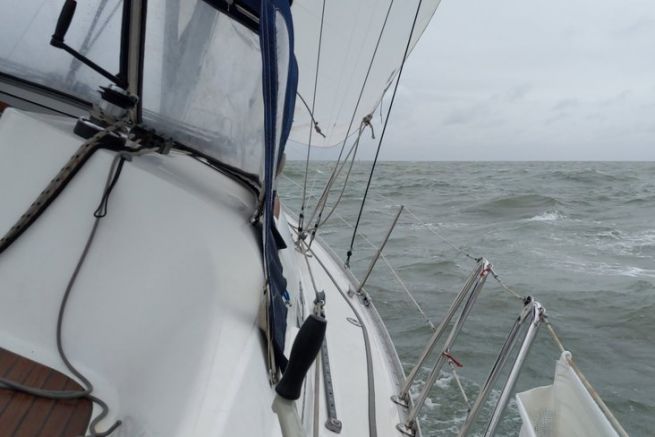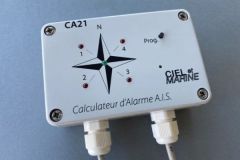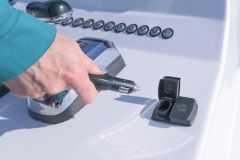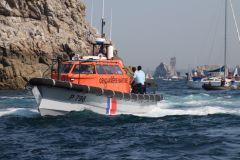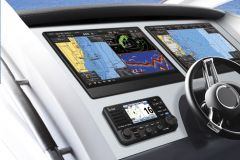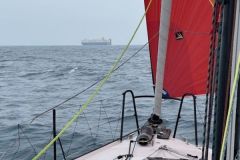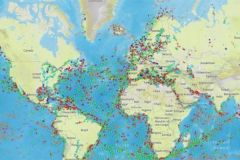Gaëlle and Jérémy are 2 thirty-somethings who have decided to travel by boat. Neophytes in sailing, they took lessons for 2 years and then bought Kerguelen, an Océanis 343 which they are preparing for the big departure.
If the health crisis does not help them in these preparations, they take the opportunity to sail the English Channel and perfect their training. It was during an outing off Ouistreham that an accident that could have gone very badly: a collision with a trawler! Gaëlle and Jérémy tell us about the misadventure.

Going back over this story is not an easy moment for us, but it allows us to show that sailing is not just about the good life, the aperitifs, the sun, the coconut trees and diving in paradisiacal places. At about 5 meters, a 30-ton trawler cut Kerguelen in half. Literally. And maybe us with it. And thanks to those 5 meters that saved us, the trawler "only" hit Kerguelen from behind, folding the gantry (where we wanted to put our solar panels) and making it unusable.
So obviously you're wondering how is it possible that we, a small 10-metre sailing boat, could be hit in such a big sea? Some will wonder why we didn't avoid the trawler (we promised we did, otherwise we might not be here today). Others will say that the trawler has priority (this is not the case, even if at sea it is often the one who has the biggest that will always be "right" in the end - well yes, the trawler didn't feel anything). We leave you with this text, in which we write a version for apprentice sailors (simplified version without the term "sailor"), and a more precise version for sailors.
Version for "apprentice sailors"
So we leave Deauville around 6:30 in the morning. It's early, but most ports discover at low tide along the Normandy coast: that is to say that it is no longer possible to access the port. So we leave when the tide allows it. The sunrise is beautiful and we sail with Marc and Maryvonne who are on their Dufour 36.
The wind is blowing from the south-west with just enough to go forward without the engine, at 3 knots (about 6 km/h).
Nothing to report on the beginning of the navigation, but in front of Ouistreham we notice two trawlers. One arriving on our right and entering the port, then another on our left which leaves the port. A trawler doesn't go at the same speed as a sailboat and they are each at about 12 knots. Four times faster than us. It's as if you're driving through town, and cars are coming in from the right and the left at 200 km/hour. In these cases, the theory (well, rather the RIPAM, the International Regulations for Preventing Collisions at Sea) is that we are a "privileged ship" (trawlers are motorboats, not in fishing action, and we are sailing, therefore less manoeuvrable). In theory, we could therefore go straight and basta. Of course, if you want to cross a pedestrian crossing and a 38-tonne comes in full pot, do you cross? I don't. It's the same for us on the sailboat: we always pass behind the trawlers, and when we cross the Channel, we pass very far behind the oil tankers and other container ships (even if in this case, they have priority over us).
So we show the first trawler our intention to go behind him and we change course a little bit. He understands, changes course very slightly and passes well ahead of us.
As we've changed course slightly, our instruments tell us that we're now going to collide with the second trawler coming from our left. We go back to our original course, and we do the same with him, indicating our intention to pass behind him.
That's where it all accelerates. It's coming in at 10 or 15 knots and you don't see it changing course. If we go even further to the left, we'll find ourselves facing the wind and we'll be in the worst situation that can happen, as we won't be able to manoeuvre any more. If we go to the right, we'll get in front of him. The closer he comes, the more we understand that there is no one in the cockpit, and the more we understand that he as we are drifting. In fact, we rarely go straight out to sea. The current often makes you crab ahead and the trajectories are harder to predict..
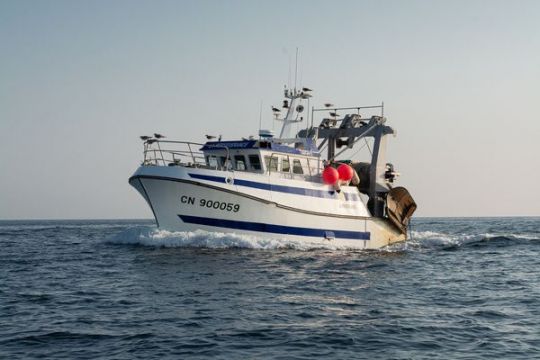
Only a few hundred meters away from us, we start the engine without even a second of warm-up. I put on full throttle and we use the foghorn. He's only a few dozen meters away from us. We shout with all our strength, hoping for a hypothetical helm stroke from him - which will never happen.
Shock is inevitable. It is immense. A metallic noise pierces us. The sailboat begins to turn on itself. We can't stop screaming. We imagine the worst: has a piece of Kerguelen's back skirt been ripped off? Are we taking on water?
I rush to the radio on channel 16 (the one where we usually hear the MAYDAYs) to call "the trawler that just hit us". No response. CROSS Jobourg (Regional Operational Surveillance and Rescue Centre) receives my call and asks me to switch to channel 68. The CROSS (with the SNSM - Société nationale de sauvetage en mer) are our guardian angels.
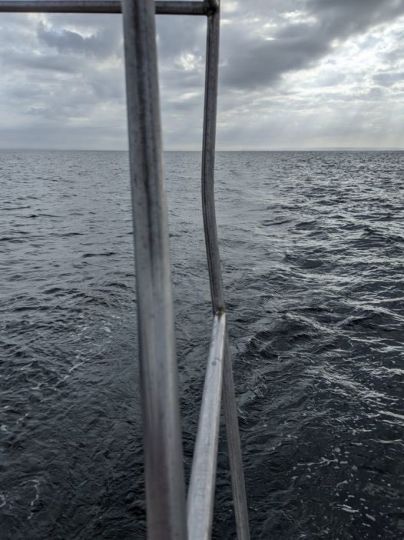
Always there to answer, always there to help. No injuries on board, we don't take on water, the sailboat can sail, but the aft gantry is folded. Two minutes later, a voice is heard: "trawler for sailboat, trawler for sailboat". So there he was, the captain, listening to our exchanges with CROSS (otherwise he would not have landed on channel 68). He is "sorry", he was "in the kitchen", he had taken a look before going down, but had not seen anyone. However, it should be known that we are equipped with a system that transmits our position permanently, that the trawlers are too, and that it was obvious that he could see us, both visually (we were all sailing outside), and electronically.
We're obviously shocked... but alive. What would have happened if this 30-tonne trawler had passed five metres further forward, at mast level, at a speed of 15 knots? A dismasting, that's for sure. An ingress of water, most likely.
We still have several hours of sailing left. We have to get the sailboat running again. Our friends Marc and Maryvonne, having heard our call on canal 16, turn around to cheer us up and escort us to Port-en-Bessin where we will arrive well before lock time.
The nights that follow are nothing but nightmares. The film goes round and round in our heads. We count the hours, 2:00 a.m., 3:00 a.m., 4:00 a.m. We see the bow of this 30-tonne trawler literally passing over Kerguelen. I only had to reach out my arm to touch it.
The insurance companies will now take over. The trawler was not given priority (or rather privileged according to RIPAM terms), did not keep a visual and radio watch. An expert is going to come by to assess the damage (which seems to be contained to the gantry and the stern skirt where we have green paint).
Since this accident, we have had occasion to start the engine several miles away from a motorboat. This story will leave its mark, but we will be all the more vigilant
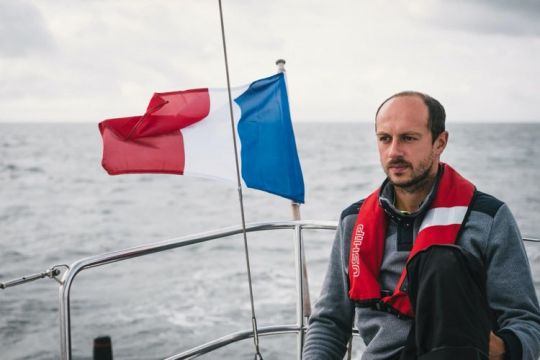
Version for sailors
About 4 miles ahead of Ouistreham, we are sailing all sails out upwind/good port tack in a force 4 south-south-westerly wind following a heading of 273° (due west). Visibility is good. At first we pass a trawler coming on our starboard side and returning to the port of Ouistreham. We indicate our intentions to pass by its stern by slightly lowering the trawler. The latter understands our intentions, changes course slightly and passes by the front of our sailboat. We then resume our course at 273°. We then come across a trawler leaving the port of Ouistreham, this time coming up on our port side. The trawler is under engine and is not in fishing action. We are both equipped with AIS. We indicate to him our intention to pass by his stern while luffing. At this point we find ourselves upwind tight and we can no longer luff. We don't shoot down, because we'd end up in front of the trawler.
The trawler continued its course at a speed of about 10 to 15 knots. We realize that no one is in the cockpit and no one is watching. We start the engine and put on full throttle. We use our foghorn in parallel, with no effect. At that point, it's clear that we're not going to be able to get through the back of the trawler, and I think that only by going through the front of the trawler can we avoid a collision where the trawler would pass over the sailboat. We pass in front of the trawler and the trawler hits our gantry.
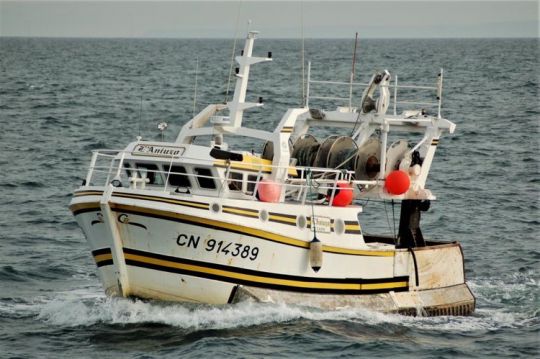
I'm rushing to the VHF to try and contact him. I ask Gaëlle his name (because we had seen him a few moments earlier on the AIS), and Gaëlle tells me that he has now disappeared from the AIS . Probably he has just cut it off. The CROSS Jobourg contacts us and we pass on channel 68. CROSS Jobourg takes note of the situation and inquires about the damage on board. After a brief exchange with CROSS, the trawler appears miraculously in the conversation, indicates not to have felt the collision and tells us that it was ... in his galley, with no one on standby and no one on the radio. And at the same time, he reappears on the AIS.
I'll exchange with him later on the phone, but the damage is done and the gantry is folded. Now it's the insurance companies' turn to play, hoping it doesn't last for centuries...
